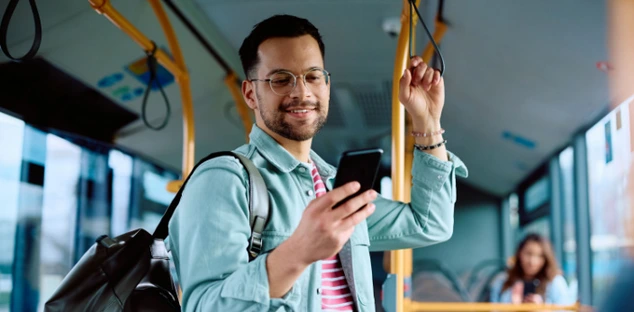Educators are realizing the lasting impact of technology on the future of education. Learn how digital transformation is reshaping language learning for students.

Digital transformation is nothing new.
A few decades ago, companies were forced to reinvent themselves in an evolving world. Since then, technology has become an integral part of everyday life—from how we live and work. And today, it has changed the way we learn.
Through a global pandemic, schools realized that future-proofing learning required a full-scale transformation. However, many of them are still organized the same way. While others haven’t embraced digital learning completely.
What else needs a rethink? Language provision in schools.
Speaking Skills for the Real World
Language skills are an essential element of global competence. In the workplace, employees who are able to communicate with respect and cultural understanding can build strong relationships with colleagues and clients.
But there’s a great mismatch between the speaking skills needed in the real world and taught skills. Only half the pupils in England learn a language at GCSE level, and half of colleges in England have stopped offering language study.
With language skills being “one of the most desired graduate employability skills”, higher education institutions need to act fast. Teachers are also struggling to pour more time into improving student outcomes, so they need all the support they can get.
Given these challenges, does technology have the answers to these problems? How will we capture the promise of technology in our schools?

How the Power of Technology Encourages Language Learning
Digital learning has become a prominent feature of 21st-century education, offering personalized instruction through technology-enhanced tools and communication. From virtual classes and modern collaboration tools to a rich content library, technology helps educators and students in many ways.
Things are changing, and now is the time to get it right. To motivate and engage students in their language learning, educational institutions should ensure their tech tools meet everyone’s needs.
Here’s how going digital aids language learning:
1. Equitable Access
When used effectively, educational technology can create equitable learning environments.
For one, students can access resources and materials outside the classroom—whether that’s around campus or at home. This lessens barriers to learning at their highest point of need. Whether they’re using mobile phones, tablets, or laptops, information is only a few clicks away.
With 70% of students preferring digital elements to course modality, it only makes sense to deliver online learning experiences for learners.
But of course, access alone isn’t enough. Schools should also take a closer look at student experiences. How many lack stable internet connections? Or technology fit for learning?
By knowing this, institutional efforts to provide devices and bandwidth to under-connected students are key.
2. Hyper-personalized Experiences
With technology, students and educators have more tools to create an environment that fosters personalized language learning.
Technology enables self-directed learning. Hence, students can search for content that interests them, and connect with live trainers. This allows students to learn at their own pace but in a way that’s suitable to their needs.
Consider this: Not everyone learns the same way. Every learner’s needs are going to be different.
So it’s up to schools to design learning around various styles and preferences. With technology, doing that is easy.
To personalize learning, educators can offer:
- A regularly updated content library with multimedia options including videos, articles, and audio files;
- Relevant content and training paths for every skill, language level, or industry;
- Access to one-on-one live sessions with a subject matter expert; and
- Opportunities for social learning with a group that has similar interests and needs.

3. Learning Community and Support
Having a sense of community is a great way to empower students to do their best learning. After all, humans are social creatures.
By interacting with other people, language learning becomes more meaningful. It gives students a safe space to apply their speaking and listening skills and enhances cultural awareness.
Like the traditional classroom setup, group lessons provide the same two-way opportunities for collaboration. This is especially important for language learners to practice their communication skills.
Students can also take individual classes with a professional live trainer. This way, they can receive instant feedback and reinforce what they have learned.
Schools must also be able to support students as they transition to online, blended, or hybrid learning. This is where learning support proves helpful.
With goFLUENT, dedicated Learning Consultants ensure learners receive round-the-clock support and assistance for their online learning classes. They also put communication programs in place to further motivate students throughout their journeys.
4. Analytics and Progress Reports
Aside from keeping track of test scores, technology can be maximized to get valuable insights into how their students are doing. How much time are they spending on the platform? What kind of content did they consume? Do they find specific media less engaging?
Not only will this help see how each student is progressing in their learning, but also determine the institution’s return on investment (ROI) as a result of digital transformation.
Having on-demand reports can help educators make informed decisions on why certain issues are happening and determine a course of action. Running it back, they can re-assess learning effectiveness.

The Future Lies in Digital Learning
More learners and teachers are embracing digital tools for their ease of use, engagement, access to course resources, and connectivity.
It’s time for institutions to do more to support the shift; to help improve the quality of teaching and facilitate more personalized, flexible, and student-centered experiences.
Harnessing the power of technology for teaching and learning is no small task. But if it’s going to make a lasting impact—future-proofing your programs and offerings, it’s worth all the investment.




